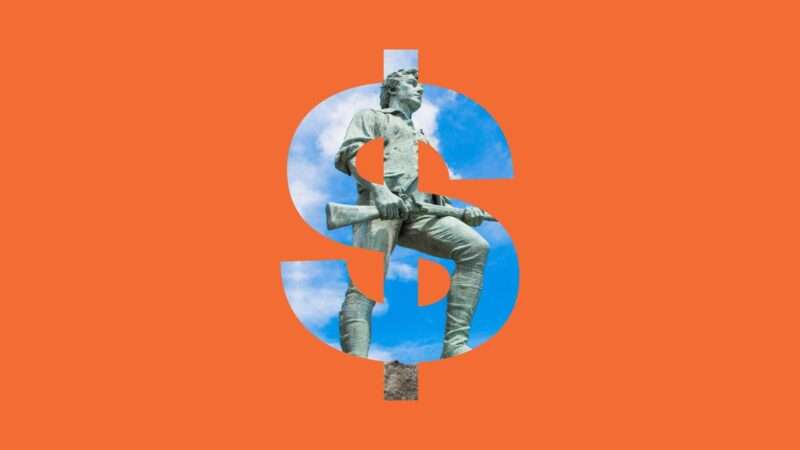
We all know freedom isn’t free, but its actual price has long been a mystery.
That’s no longer the case thanks to the work of three Australian researchers who have estimated out how much people are willing to pay for the sweet blessing of liberty by comparing changes in home prices and rents in and outside of areas affected by their country’s strictest pandemic lockdown regime.
Beginning in March 2020, the government of the Australian state of Victoria ordered businesses statewide to close and people to shelter in their homes except when engaging in a few permitted activities like receiving medical care or shopping for essential goods.
These restrictions were eased in June. But a second wave of COVID-19 cases in July saw the Victorian government impose another lockdown regime, this time with a crucial difference.
Everything inside the boundaries of Metropolitan Melbourne, the state’s largest city, was subject to draconian “Stage 4” restrictions that prohibited pretty much all social activity. People were even prevented from travelling more than five kilometers from their homes.
The areas of the state located outside this boundary—which public officials called the eyebrow-raising “Ring of Steel”—were subject to less severe restrictions that were also eased more quickly.
It wasn’t until November 2020 that areas inside and outside the Ring of Steel were both operating under the same public health restrictions.
In a paper uploaded to SSRN last week, Deakin University professors Chyi Lin Lee and Jian Liang, and Qiang Li of New South Wales University exploit the policy differences on either side of the Ring of Steel to tease out the monetary value people placed on not living under a COVID security state.
These researchers used a database of home sales and rental transactions to measures changes in home values and rents in suburban communities located within a few kilometers of the Ring of Steel boundary during the successive stages of Victoria’s lockdowns.
Focusing on home sales and rents in suburban communities just a few kilometers from the Ring of Steel, researchers said, helps them filter out price declines that would have come from a general fall in demand for dense urban living within municipal Melbourne during the pandemic.
During Victoria’s first March-to-June lockdown—when the whole state was subject to the same restrictions—these researchers found no statistically difference in the change in home prices and rents within 2.5 kilometers of the Ring of Steel boundary.
But during the second lockdown between July and November 2020—when the Ring of Steel was established—home sale prices within the boundary dropped by 1.8-3.1 percent when compared to home sales outside of it. Researchers found a similar divergence in rents.
This divergence in home sale values and rents grew to 6.3-7 percent from November 2020 to January 2021, when the Ring of Steel was lifted and public health restrictions were eased in both areas.
Liang, Lee, and Li argue that this reflects peoples’ continued worry that a harsh lockdown would be reimposed in the metropolitan Melbourne area.
“These findings indicate that the residents perceive that the area within the Ring of Steel faces a higher risk of lockdown restrictions,” they write. “The perception of lockdown risk drives demand from the area with a high lockdown risk to that with a low lockdown risk.”
Their paper notes that government officials repeatedly stressed the importance of Ring of Steel as a pandemic fighting measure, which they say contributed to the perceived fear that more lockdowns would be on the horizon.
Using this decline in rents, Liang, Lee, and Li estimate a weekly cost of public health restrictions within the Ring of Steel at $14 to $34 million. That figure, researchers note, is likely an underestimate given that areas outside Metropolitan Melbourne were not totally free of public health restrictions.
The natural experiment created by Victoria’s Ring of Steel provides certainly provides an interesting opportunity to measure how much value people put on being free from some of the harshest pandemic restrictions we’ve seen in the developed world.
Domestic migration within the U.S. during the COVID-19 pandemic plausibly tells a similar story. A paper published by the Federal Reserve Bank of Kansas in November found that the pandemic, while generally leaving pre-COVID migration patterns untouched, did accelerate an out-migration from America’s largest urban areas.
Fed researchers Jason Brown and Colton Tousey chalk this up people’s attempt to mitigate the perceived risk of COVID-19 that comes with living in a dense urban area and their desire to escape strict lockdown measures—which have generally been harshest within the country’s largest cities.
Unlike in Melbourne, however, rents and occupancy rates are shooting up from pandemic-era lows in major U.S. cities like New York and San Francisco.
That could plausibly be explained by policymakers in those cities shying away from costly and broadly unpopular lockdowns and capacity restrictions. Those have been replaced by mask mandates and vaccine passport systems, which liberal city dwellers have found to be more tolerable or even desirable.
Were harsher measures to come back, people might vote with their feet again and decamp for smaller, freer metro areas—even if the cost of doing so goes up a few percentage points.
The post How Much Would You Pay To Escape Australia's COVID 'Ring of Steel'? appeared first on Reason.com.
from Latest – Reason.com https://ift.tt/3IioQEJ
via IFTTT